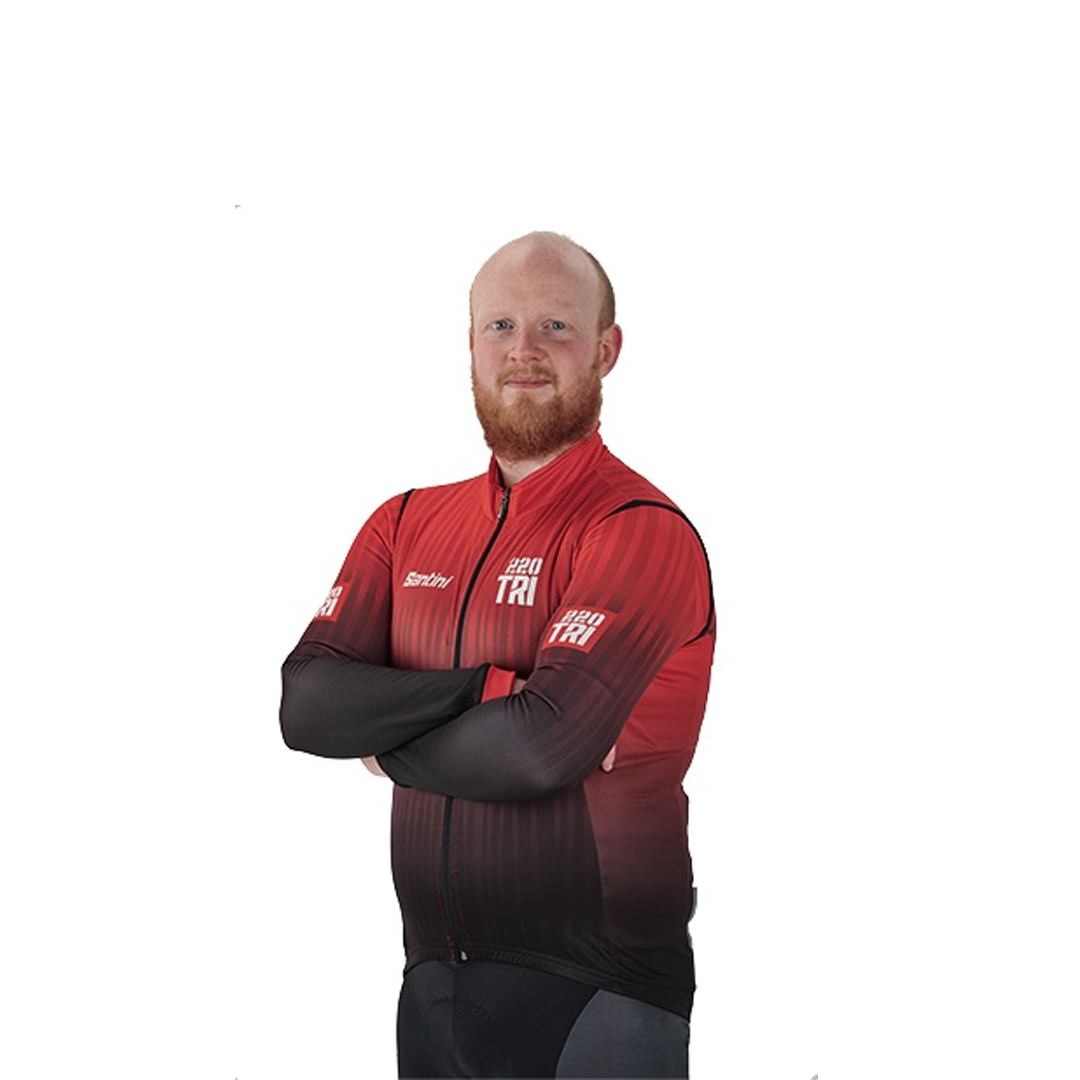Clip-on aerobars, which are also known as triathlon bars, are handlebar extensions with padded forearm rests that allow the rider to get into a more aerodynamic position by drawing their body forward into a tucked position, with a dropped torso.
If you want to make your bike faster, tri-bars should be one of your first purchases. Here are our top 11, plus a guide underneath about what they are and what makes the best aerobars so good...
Tried and tested: Best clip-on aerobars at a glance:
- Best budget choice: Van Rysel Long-Distance Triathlon Extensions | Buy now from Decathlon (£39.99)
- Best in test: Zipp Vuka Clip | Buy now from Tredz (£154)
- Best for draft-legal racing: Prime Carbon Clip-on | Buy now from Wiggle (£119.99)
Best clip-on aerobars in 2024
Zipp Vuka Clip
Buy now from Amazon
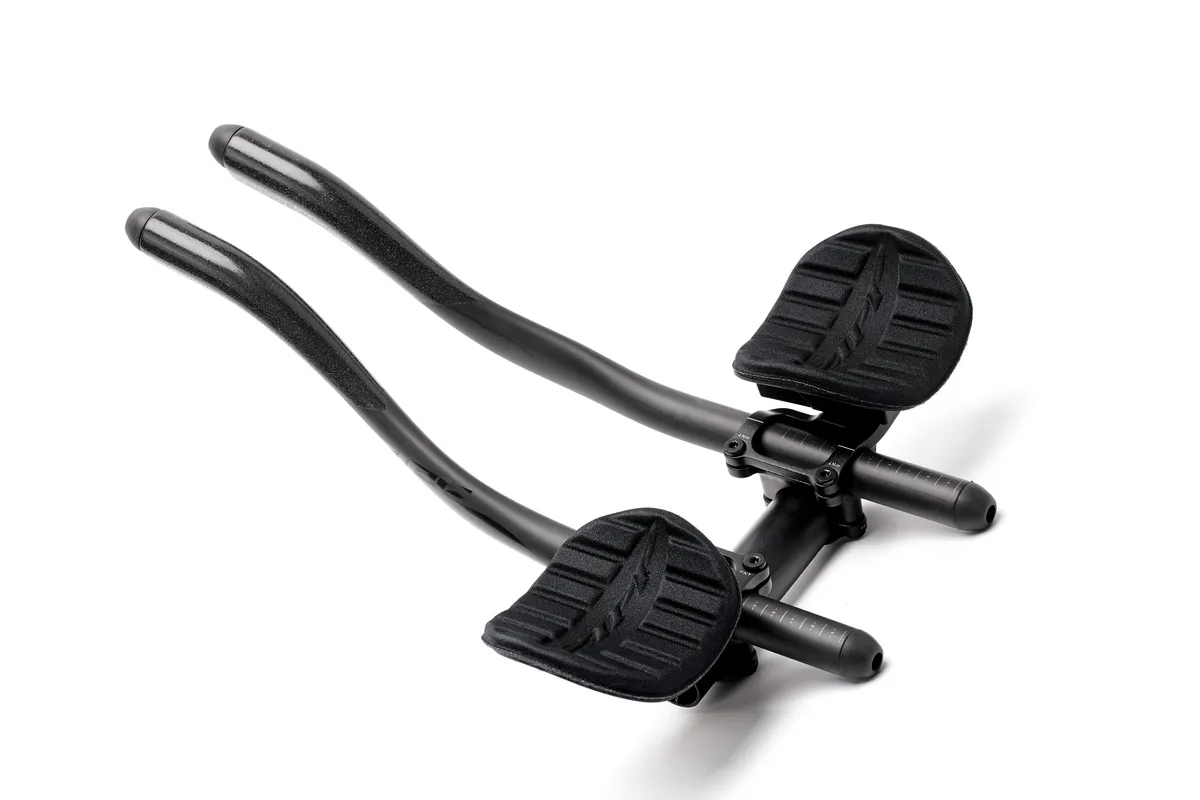
- £233 / $288
Zipp’s Vuka Clip bars are available in aluminium or carbon – we tested the luxurious latter version, weighing 218g per bar including the clamp.
The standard 31.8mm clamp makes it suitable for use as a clipon with drop bars, or on a full tri rig with Zipp’s own Vuka Alumina Base Bar or Vuka Bull.
Extra wedges are included to increase the armrest angle by up to 15°, which you’ll appreciate if you favour a ‘mantis’ position. It also supports internal cabling to route gear shifters through if you intend to use on a tri bike.
Set-up is simple with two T25 bolts either side to tighten the extension clamp to your drops, and another two T25 bolts on top to tighten bars to the clamp.
There’s a handy key on the bars to dial in the fore/aft of the extensions. Carbon assembly paste is included to prevent slippage between the clamp and base bars you’re mounting to.
Zipp say that the Vuka Clip was born out of ‘data compiled from thousands of fit sessions’ to help riders maintain their aero tuck for longer, and it shows in how ergonomic the extension is.
The bend and the shape place the wrists in a highly comfortable position, and coupled with the wide, dense arm pads, we felt like we could stay out on the aerobars all day long.
Verdict: expensive, but brilliantly ergonomic and lots of adjustment on offer
Score: 90%
Profile Design T5 Aerobar
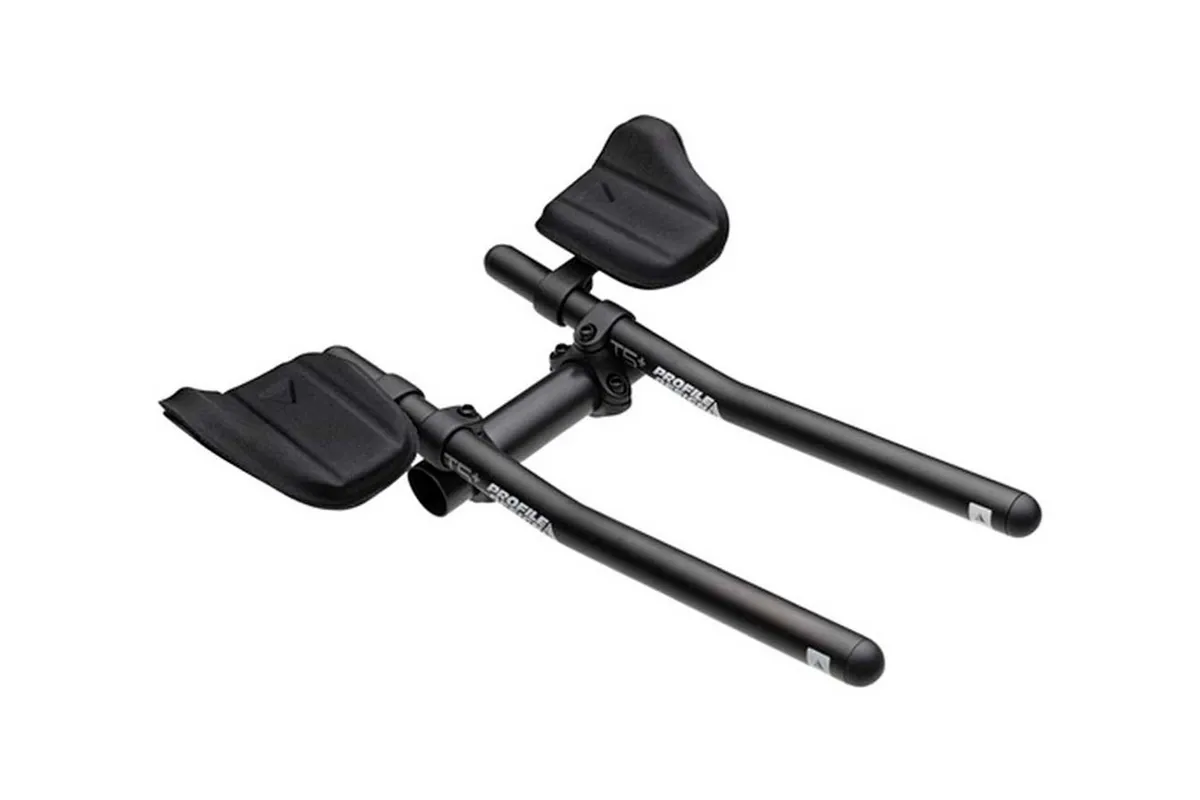
- £109.99 / $158
Don’t be concerned by the relatively low price and the simple appearance: Profile Design’s T5 Aluminium are a reliable pair of aerobars.
Unlike the other bars on test, the mounts for the armrest and the extensions are independent, meaning that you can move the pads back from your handlebars and tilt them without affecting the angle of the ski arms.
Installation is very easy; all you need is a 5mm Allen key and a torque wrench. The extensions have a classic appearance with a subtle 15º bend and, like the other test bars, have ports for internal cable routing.
But there are questions about the long-term durability of the pads, especially if being frequently used indoors on the turbo, and, despite being tightened securely, when riding over potholes the bars tended to move slightly.
Verdict: ignore the lack of glamour, these are a good option without breaking the bank
Score: 77%
Vision Trimax Adjustable TT
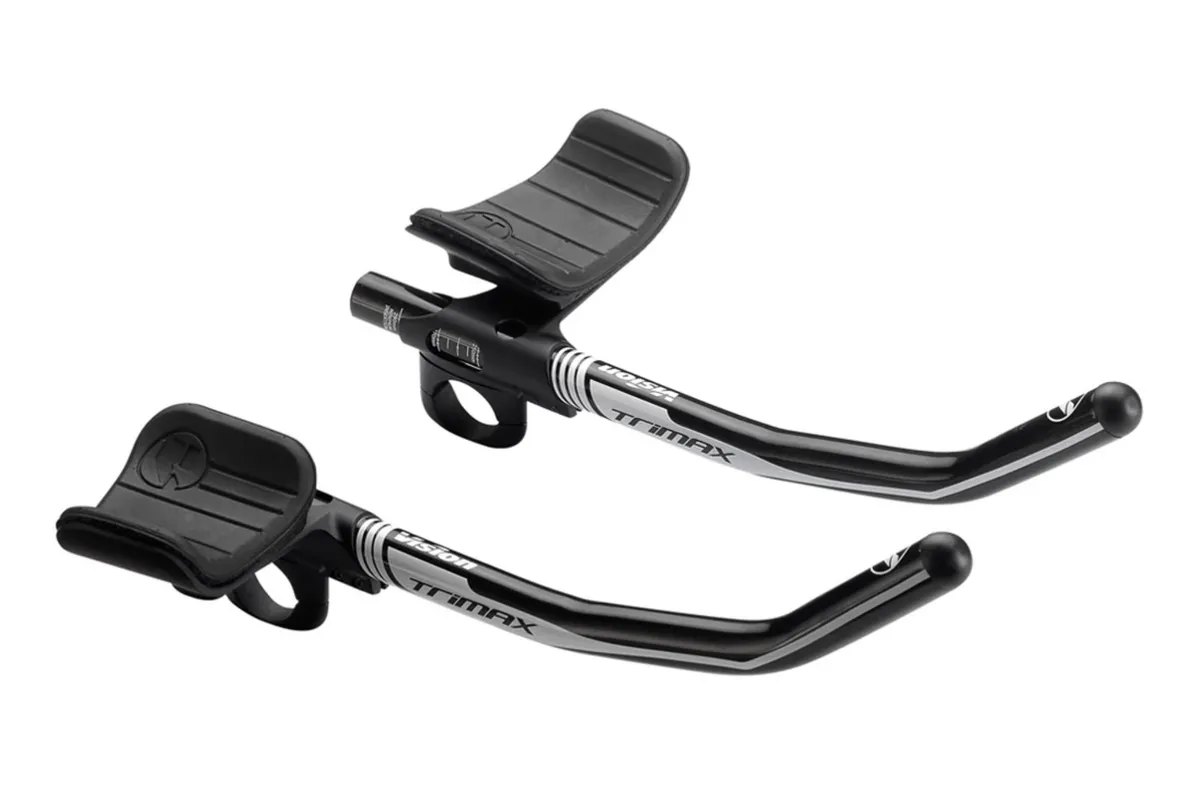
- £179.95 / $224
The highly-adjustable Trimax certainly live up to their name. With 40mm of lateral movement you should be able to find a comfortable position for the armrests.
If you’re a fan of a slammed stem, or like to hold the tops of your handlebars when taking a breather, you’ll appreciate the height offered by the Trimax’s bracket and stack spacers.
Yet this bracket is quite substantial and contributes to the Trimax being the heaviest bar set-up on test (claimed weight of 667g).
Once the mount and pads are installed, you slide the alloy ski arms in and fix them in place. Although tightening the extension bolts is a little fiddly, even when at the recommended torque under force they rotate and the white decals don’t last long.
The shallow J-bend bars really do look the part and allow you to get a good position, but for longer rides we’d prefer thicker pads.
Verdict: A solid set of clip-on bars, but for £180 they’re behind the competition.
Score: 70%
BBB AeroBase
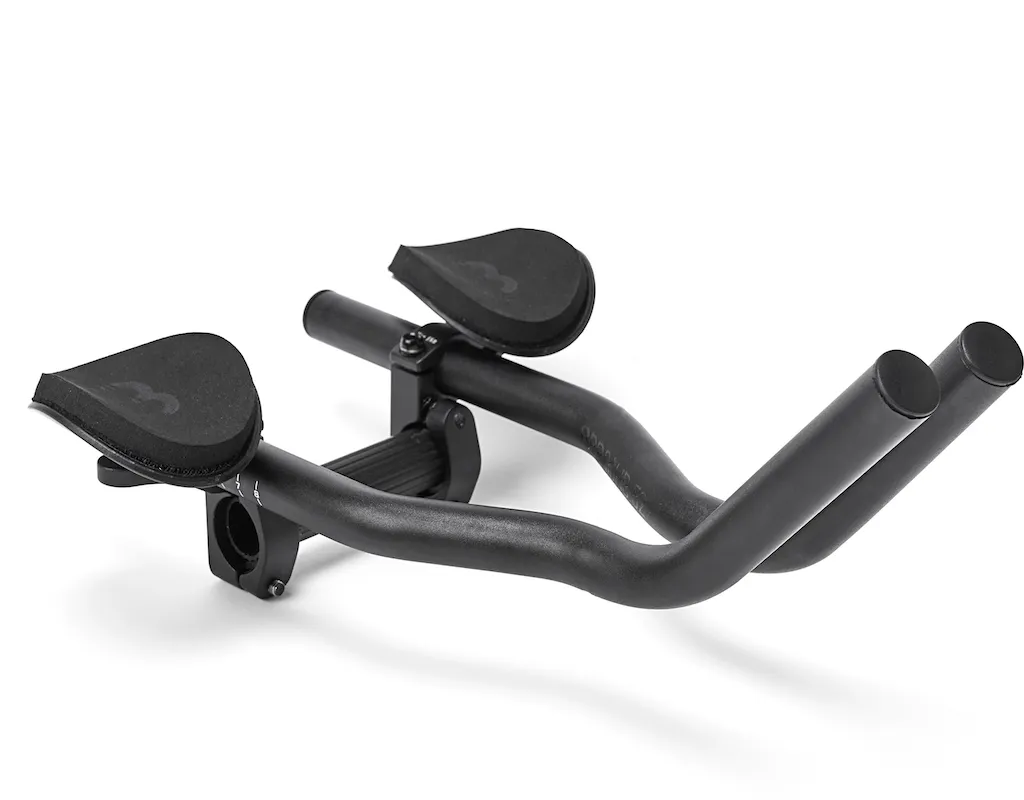
- £64.95 / $82.02
Hit the sub-£100 price point and the compromises immediately begin to show in the AeroBase from BBB’s four-strong clip-on range.
That's most evident in the cheap pads and sheer lack of adjustability options underneath them (just two fore/aft and width settings).
And yet there’s much here to please clip-on newcomers beyond the price, with an 80mm range of bar extension meaning this tester found his desired fit easier than all on test (very tall riders might want more than the 365mm bar extensions, however).
We also liked the ergo-bend extensions and their steeper angle on the bike, while some neat metallic clamps are included to add more mid-ride security and protection between your bike’s handlebar and the system itself.
That said, the cheaper material doesn’t reduce road buzz as well as pricier options, so add bar tape for more protection. Weight for the complete aluminium set comes in at 509g.
Verdict: Well-shaped extensions and range make these a smart clip-on intro.
Score: 80%
Profile Design Subsonic Ergo 35A

- £179.99 / $229
Whether it’s the brand’s fully-integrated sets or clip-ons, Profile has long been one of the dominant forces in aerobar design.
That theme continues in the Subsonic, the chief tech being the mid-mount positioning so they extend in-line with the handlebar to secure a position that’s at least 20mm lower than most upper-mount bars (see the BBB).
The 35a standard aluminium extensions offer a, yep, 35° angle and an 80mm rise. Combined with 80 different positions from the rotating pads and the adjustability options are high.
Yet there are bars that offer more than the 40mm range of length extension, with the standard Sonic Ergos more appealing for less flexible age-groupers (at 168cm tall, we were overreaching and wanted to bring the extensions closer).
The wide pads are great for arm support and set-up is easy, but weight is high at 590g.
Verdict: Great for those getting low, but the standard Sonics have broader appeal.
Score: 78%
Deda Elementi Superzero Extensions
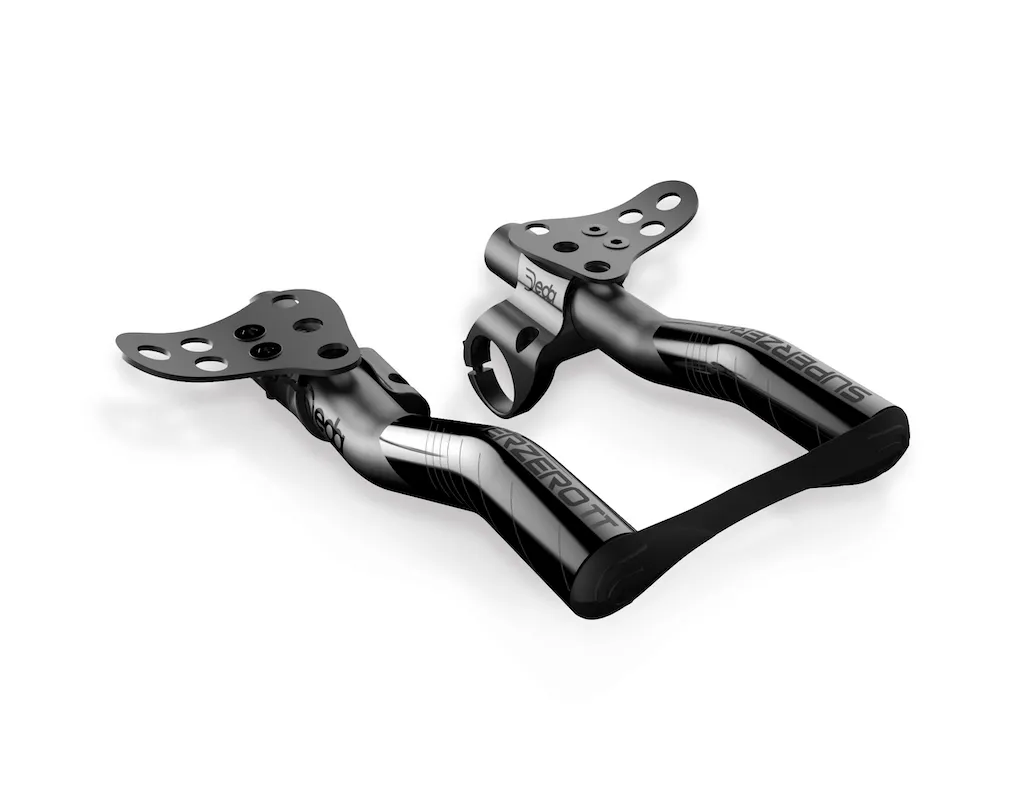
- £202.99 / $180
You’ll regularly see stubby clip-on bars at ITU pro racing, the USP being that they’re allowed in draft-legal racing as they don’t extend further than the brake hoods and have a bridge linking the arms (the bridge can be removed, too).
As for age-grouper non-drafting appeal, it’s now limited to U23, Junior and Youth racing by the ITU in 2023.
Onto the bar’s performance, and the carbon build is smartly constructed and lightweight (330g for the complete set), and they’re easy to mount onto handlebars.
The obvious downside is that the tiny pads aren’t designed for lengthy periods, adjustability is limited, and you can’t extend fully into an aero position compared to conventional full-length tri-bars.
This all makes the Deda pretty niche, but we can see the appeal in hilly non-drafting events with irregular flat sections, long-distance touring and bikepacking.
Verdict: Well-crafted and lightweight, but not the broadest appeal for triathlon.
Score: 75%
Van Rysel Long-Distance Triathlon Extensions
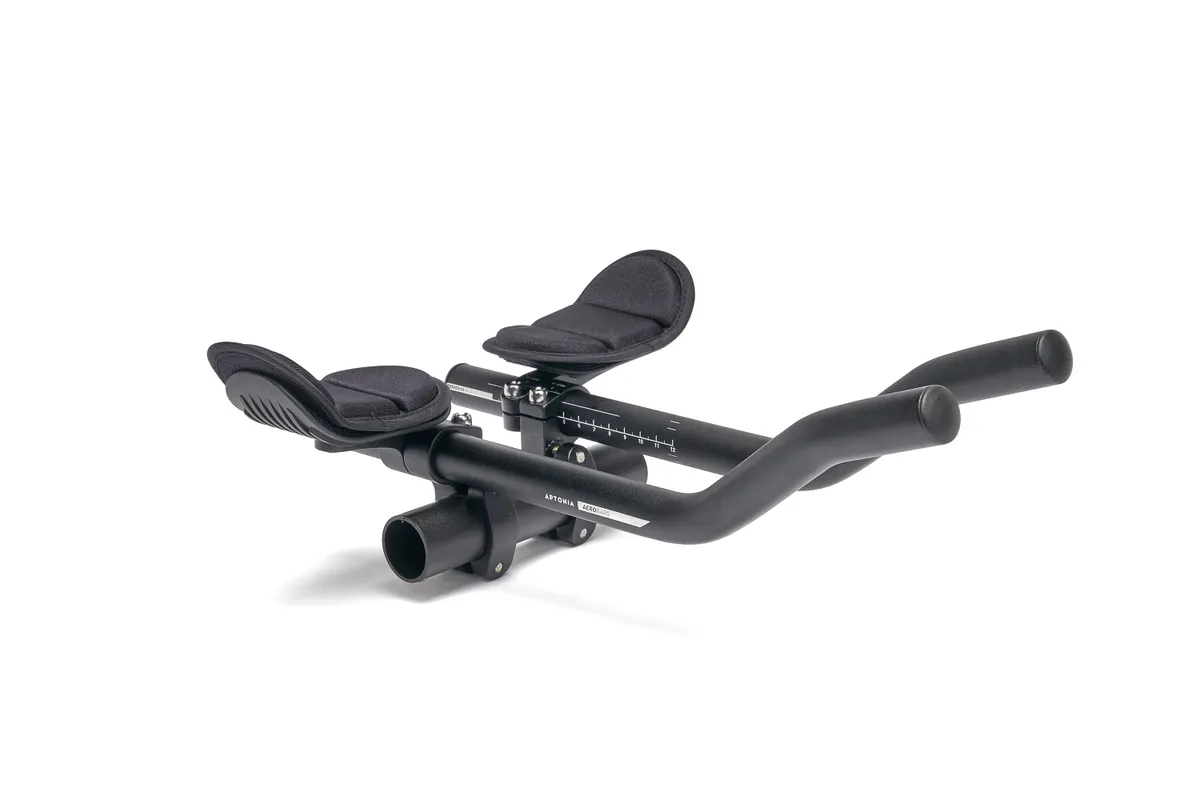
- £39.99
These no-frills bars from Decathlon aren’t the comfiest, lightest or most adjustable, but for under £35 they’re a cheap way to upgrade your road bike.
The clamp will fit 31.8mm or 26mm drop bars and the aluminium extensions have a measuring scale etched on so you can note your preferred length if you need to remove and reaffix.
There’s also some armrest adjustability to achieve your preferred forearm position. We found the position we dialled in comfy enough for short efforts.
The foam padding doesn’t cover much of your arm, so for middle to long distance, where you’ll often be in a fixed position, you might prefer bars that have larger, comfier pads.
They weigh 490g for the pair, not even the heaviest in this test, although the extensions are quite short. Overall, it’s another bargain from the French brand.
Verdict: Extensions that do the job impressively at a jaw-droppingly minor cost
Score: 85%
Vision Trimax Clip-on
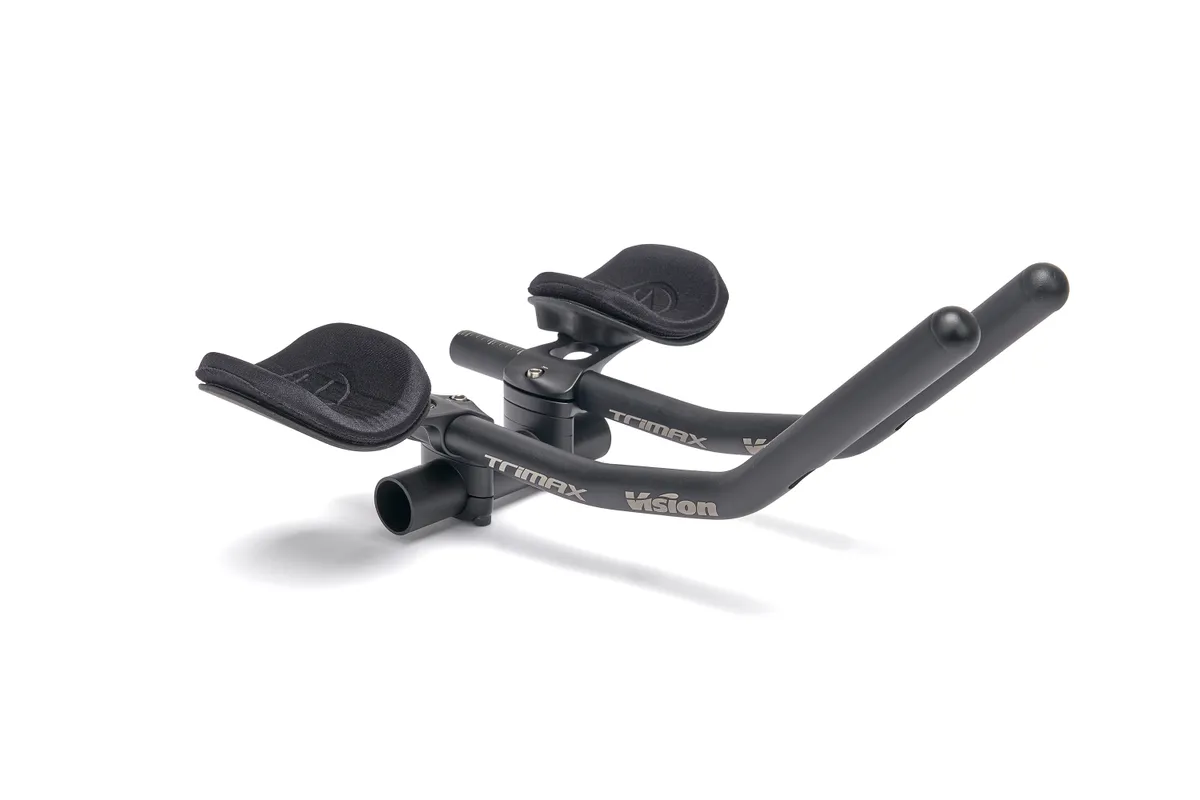
- £197 / $224
For the price, you might expect carbon on Vision’s Trimax bars. However, the aluminium extensions you do get have a pleasing shape in their J-bend formation (S-bend and JS bend options are available) and include everything you need for a high-end tri-bike set-up, or to attach to your road bike.
For the former, there’s an adjustment guide on both ends to dial your position and do any necessary chopping if you need to route shifters through.
There are also gaps for routing electronic gear cables. We ran the bars on our road bike and found the range of adjustment impressive.
A removable 10mm of stack came with the bars to lower or raise the forearms, and there’s plenty of adjustment at the armrests. The foam on the pads is large and will cradle your elbow and some of your forearm, ideal for longdistance tri.
Verdict: Plenty of adjustment, but expensive compared to the rest and uses aluminium instead of carbon
Score: 76%
Prime Noosa Carbon Clip-on
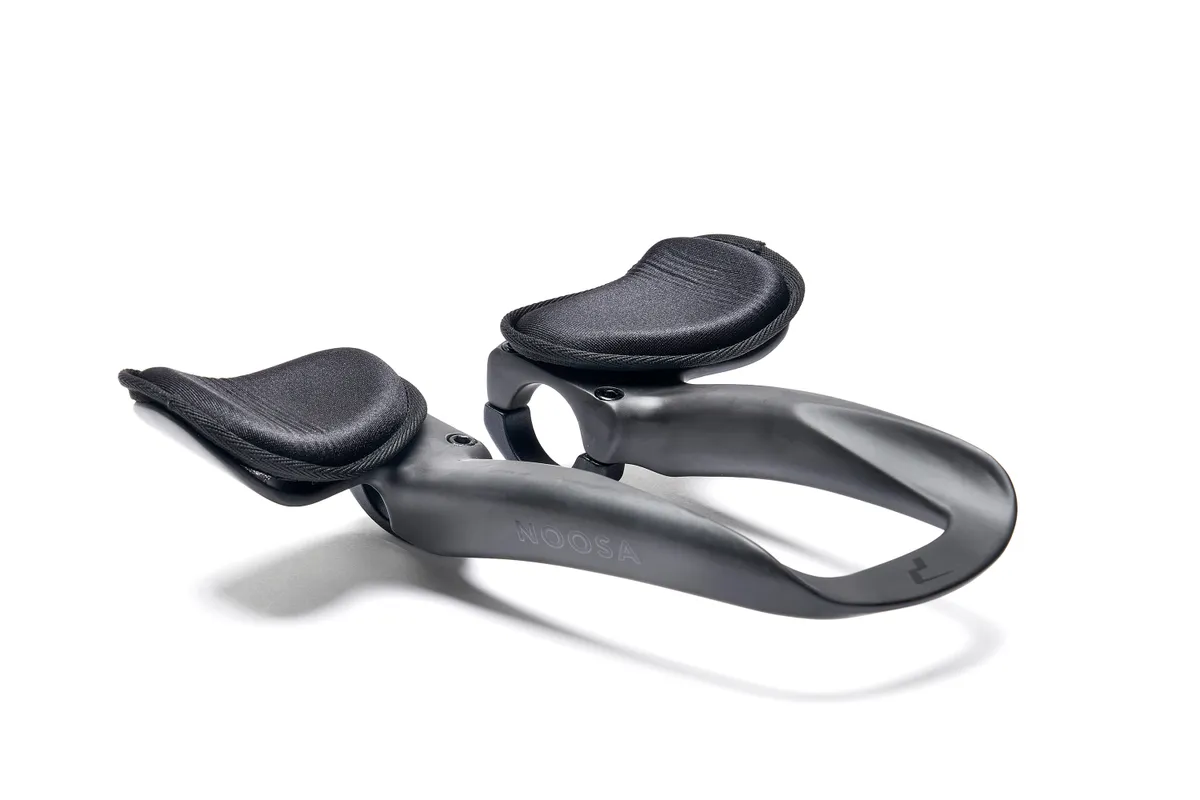
- £119.99 / $129.99
These bars aren’t the best for non-drafting racing due to the reduced length and aero benefit, but we think they’re ideal for the job they’re intended for: draft-legal tri and long-distance cycling.
At just 280g, they fit standard 31.8mm bars and the extensions are made from vibrationdampening unidirectional carbon.
The pads are small and not very plush, but for short bursts on a draft-legal course this is all an elite triathlete needs. The extensions are cut away on each side so your thumbs sit comfortably, which is highly ergonomic.
The narrow width means you can’t run a conventional out-front computer mount, so you’ll need a direct under-stem mount instead.
The Noosa is also a great option for longdistance touring trips where you want a different position, and a riser kit is available to make this even more comfy.
Verdict: Super light and draft-legal bars that are highly ergonomic and represent great value
Score: 88%
Profile Design Sonic Ergo 45/25A
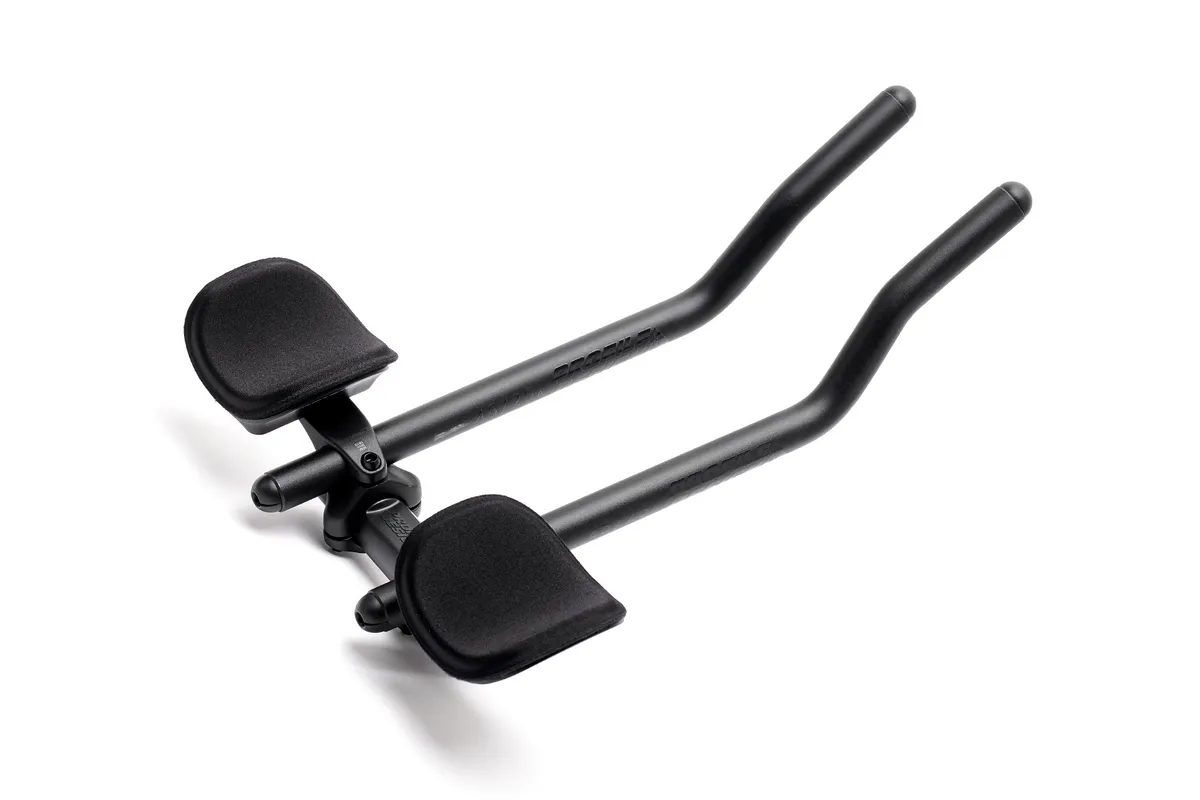
- £139.99 / $173
The Sonic Ergo from Profile Design is available with a number of different extension options; the 45/25a here features an S-bend bar that curves upwards.
We weighed each bar plus its clamp at 284g each, not a great deal heavier than the carbon Zipp bars.
Profile Design claim it’s ‘the most adjustable clip-on bar on the market’, with a huge number of configurations possible thanks to the risers and 15 different positions for each arm pad. There are also inserts for internal cabling.
Getting set up on your drops or base bars is very easy, with just a 5mm hex key needed to screw the single top bolt down, and two on the underside to secure the clamp.
The bars are 40cm long, which should be enough even for super tall riders who need lots of reach, and there’s a scale on the underside to mark your ideal bar length.
We found the pads on the firm side, so not the most comfortable on a longer ride; we’d probably put some bar tape on the extensions for anything longer than a sprint.
While the Sonic Ergo costs significantly less than the Vuka Clip, it loses out here due to the middling levels of comfort and standard round aluminium extensions, plus the Vuka’s option to adjust the armrest angle with wedges
Verdict: A more basic set of clip-ons with some notable extra features.
Score: 80%
Bontrager Race X Lite
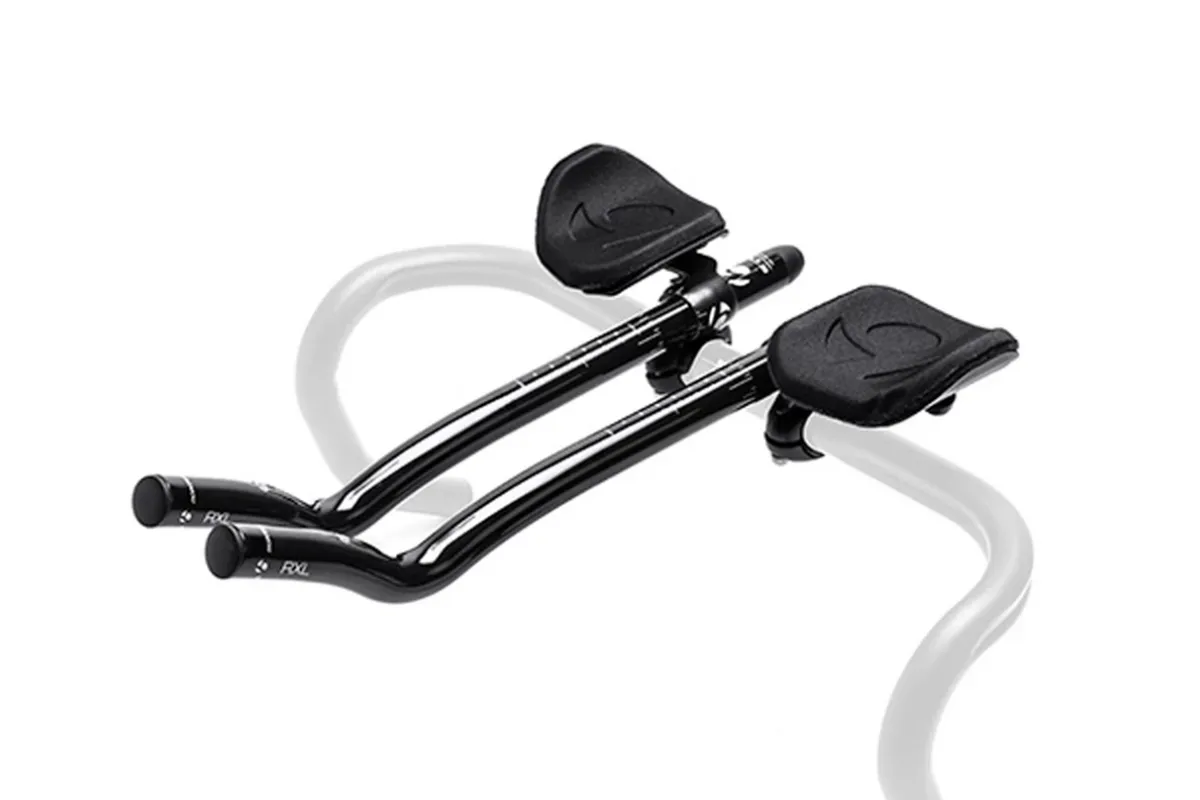
- £159.99 / $125.99
You’d expect a set of clip-on bars with carbon extensions to be light and, with a claimed weight of only 425g, this offering from Bontrager is noticeably the lightest on test; and at a competitive price, too.
With measurements on the extensions helping you to get the desired position, setting up the bars is straightforward, but a torque wrench is a must when pairing alloy and carbon!
The ergonomic-shaped ski arms start straight and have a short kick up for your hands to rest at a comfortable angle, without having to over rotate your wrists, but those with larger hands may need to grasp the end of the extension.
The pad stack height of only 43mm lets you get a low profile and the position of the armrests are easy to alter. Yet a minor gripe is that, to stop them moving, it feels like you’re at risk of over tightening the bolts.
Verdict: Sharp and light bars, but the profile won’t suit all.
Score: 82%
What are clip-on aerobars?
Aerobars, which are also known as triathlon bars, are handlebar extensions with padded forearm rests that allow the rider to get into a more aerodynamic position by drawing their body forward into a tucked position, with a dropped torso.
‘Clip-on’ styles can be added quickly and easily as they bolt onto both normal handlebars and aero base bars (aka cowhorns).
Clip-on aerobars cost around £50, with prices rising depending on materials and weight.
Complete ‘combi’ bars (base bars with integrated aerobar extensions) are more expensive and theoretically more aero.
How we tested
The clip-on aerobars reviewed here have been tested by former 220 Triathlon staff members Jack Sexty and Matt Baird, who both have years of triathlon and gear testing behind them.
To test these aerobars, we set them up on our own bikes and took them for multiple rides, judging them on ease of set-up, weight, value, comfort, adjustability and suitability to real-world triathlon racing.
See our guide on the key aspects of clip-on aerobars below for more insight into our testing criteria.
What to look for in the best clip-on aerobars
Extensions
For non-drafting races, these come in a number of shapes, from straight to ski-curves, allowing a variety of hand positions.
Choose based on personal fitness, adjustability and comfort, not what looks fastest or what the pros are using.
For draft-legal races, the extensions cannot extend more than 15cm in front of the wheel axle or the brake levers’ foremost line. They must also be bridged.
Pads
For a non-drafting set-up, pads should support your arms at or near your elbows and your shoulders should be close to perpendicular above them.
Look for width, rotational adjustment and the ability to remove for washing.
On draft-legal bars, there often aren’t pads or they’ll be more minimal. You won’t be on the aerobars for extended periods, you won’t be so far forward and any pads will give your forearms a bit of support.
Risers
A key component for adjusting the height of the elbow pads.
As risers can be more aerodynamically shaped than stem spacers, running your base bar low and using risers to add stack height is the faster set-up.
However, gains will be fairly marginal so, if you also need a couple of stem spacers to get your position right, don’t stress too much.
How should aerobars fit?
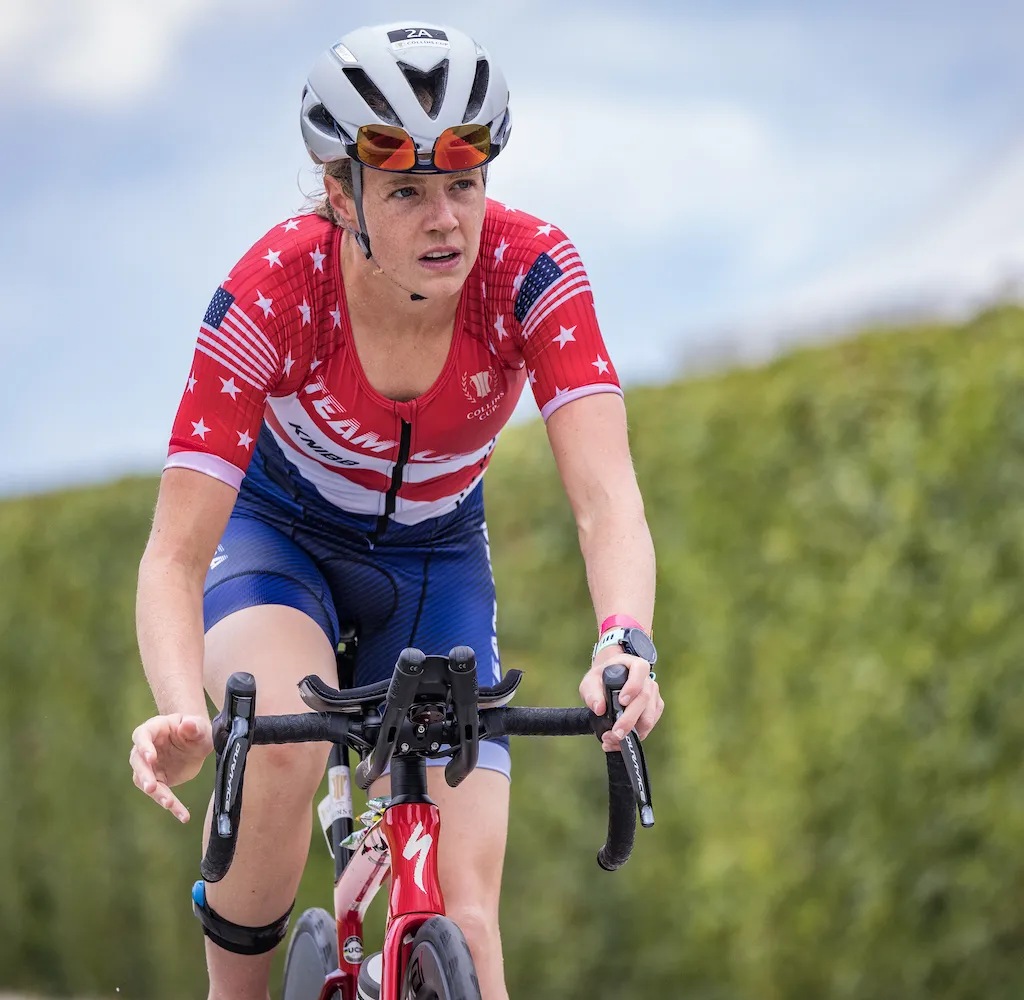
An optimal aero handlebar set-up favours the minimum frontal area with your forearms extended out in front of you.
The closer together you can comfortably get your elbows, the better, as they’ll act like a fairing and direct the airflow around the rest of your body.
Your back should then be as flat as you can make it with your knees just skimming your chest when they pass through the top of the pedal stroke.
Adjustability is a vital factor when it comes to aerobars, as the wrong set-up can impact greatly on speed and comfort.
For many novice triathletes, their first aero upgrade is to bolt a set of clip-on aerobars to their road bike and expect chunks of time to fall off their bike split.
Yet many find they end up slower and more uncomfortable. Road bikes have a different geometry to dedicated TT bikes and this has to be considered when fitting aerobars.
As Phil Burt, lead physiotherapist of the Great Britain Cycling Team and author of Bike Fit: Optimise Your Bike Position for High Performance and Injury Avoidance, explains: “A road bike and a TT position won’t be compatible unless you make a few more adjustments than simply clipping on a set of aerobars.
"Your normal riding position has to be rotated forwards for an effective aero tuck but without stretching you out too much and compressing your hip angle.
"The seat angle and top tube length on most road bikes make this hard to do. You’ll probably need to move your saddle forwards, maybe fit a seatpost that steepens the seat angle and obviously adjust your saddle height to accommodate these changes.
"At the front end, you’ll also probably need to consider a shorter stem to reduce reach. Once you have the position right, it’s then essential that you train in it and don’t wait until race day.”
How did aerobars become popular
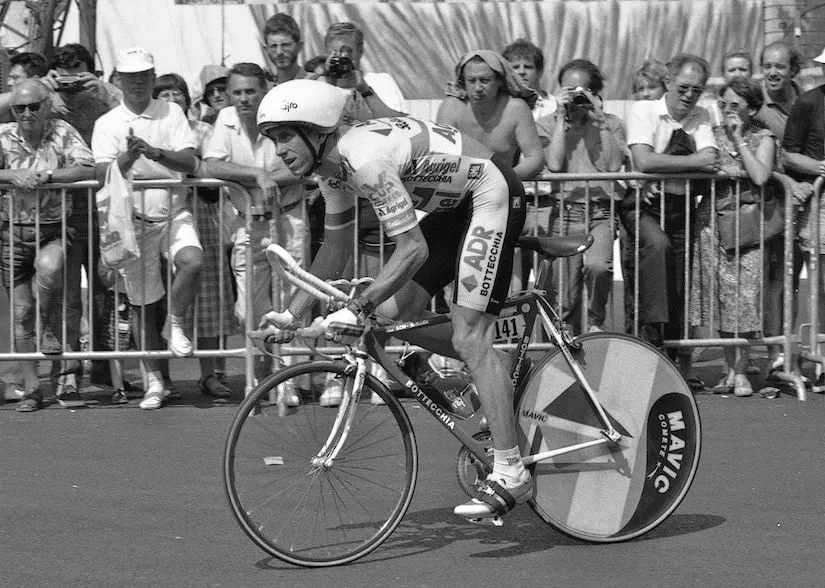
Anyone with a passing interest in the history of professional cycling will tell you that aerobars came to the fore following Greg LeMond’s 1989 Tour de France victory.
The American was convinced by Boone Lennon of Scott USA to bolt on the company’s revolutionary DH aluminium aerobars, instead of just using cowhorn-style bars found on most time-trial bikes of the era.
The result? LeMond was 50secs down on race leader Laurent Fignon going into the final stage, a 24km time trial finishing on the Champs- Élysées.
But with his new bars, teardrop-shaped aero helmet and a rear disc wheel paired with a shallower front, he pulled back a massive 58secs to win the general classification by the closest margin of victory in the race’s history.
So how did Lennon manage to persuade LeMond that aerobars were the way forward? It’s largely thanks to their early adoption in triathlon.
Before Scott began supplying prototypes of their aerobars to pro triathletes faster than they could make them, Scott Tinley was the first to use a handlebar specifically designed for aerodynamics at the Ironman World Champs in 1985, and promptly broke the course record.
Although Scott USA weren’t the first to make an aerobar, they patented the idea and brought them to the mass market by showcasing their creation on cycling’s biggest stage.
Scott ruled the aerobar roost until their patent ran out in 2006, with only Profile Design and Syntace getting permission to make similar products throughout the 1990s and early 2000s.
When the floodgates opened, brands such as Zipp, 3T and Vision began entering the ring, and today there’s a huge array of aerobar designs to choose from.
For more aerodynamic triathlon kit, take a look at our lists of the best aero road helmets and the best triathlon bikes.
